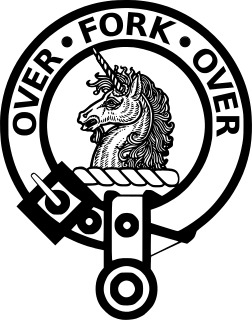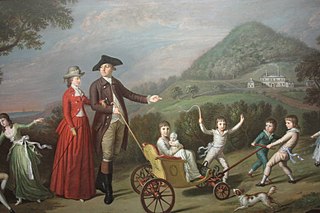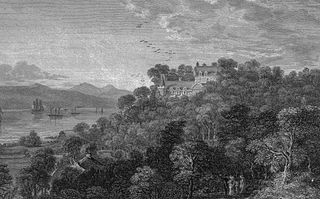Related Research Articles

Sir Thomas Miller, 1st Baronet FRSE, known as Lord Barskimming (1766–88) and Lord Glenlee during his judicial service, was a Scottish advocate, judge, politician and landowner. He was a founder member of the Royal Society of Edinburgh in 1783, and served as the Society's first Vice-President, 1783 to 1786.

The Fergusson Baronetcy, of Kilkerran in the County of Ayr, is a title in the Baronetage of Nova Scotia. It was created on 30 November 1703 for the prominent advocate John Fergusson. The second Baronet represented Sutherland in the House of Commons and served as a Lord of Session under the judicial title Lord Kilkerran. The third Baronet sat as Member of Parliament for Ayrshire and Edinburgh. In 1796 he claimed the earldom of Glencairn. The House of Lords decided that he had successfully proved that he was heir-general to Alexander Cunningham, 10th Earl of Glencairn, but that he had not proved his right to the earldom. The sixth Baronet was a Conservative politician and colonial governor and notably served as Governor of New Zealand from 1873 to 1874 and as Governor of Bombay from 1880 to 1885. The seventh Baronet was Governor-General of New Zealand between 1924 and 1930. The eighth Baronet was an author and historian and also served as Lord-Lieutenant of Ayrshire.
Perceton is a medieval settlement and old country estate in North Ayrshire, Scotland, near the town of Irvine. The ruined church in Perceton is one of the oldest buildings in the Irvine district. The earliest legible gravestone dates from 1698, though older stone coffins will certainly still rest deep within the small hillock on which the chapel and graveyard sit.
Chapeltoun is an estate on the banks of the Annick Water in East Ayrshire, Scotland. This is a rural area famous for its milk and cheese production and the Ayrshire or Dunlop breed of cattle.

Lambroughton is a village in the old Barony of Kilmaurs, Scotland. This is a rural area famous for its milk and cheese production and the Ayrshire or Dunlop breed of cattle.
Cunninghamhead is a hamlet in North Ayrshire, Scotland. It was the centre of the lands of Cunninghamhead, Perceton and Annick Lodge in Cunninghame. This mainly rural area is noted for its milk and cheese production and the Ayrshire, Cunninghame or Dunlop breed of cattle.
The baronetcy of Cuninghame of Corsehill was created in the Baronetage of Nova Scotia and conferred upon Alexander Cuninghame of Corsehill, a Scottish baron and landowner in Dumfriesshire and a great-great-great-grandson of the 4th Earl of Glencairn. The fourth baronet's father added the name Montgomery before his own on inheriting the estate of Kirktonholm.

Clan Cunningham is a Scottish clan. The traditional origins of the clan are placed in the 12th century. However, the first contemporary record of the clan chiefs is in the thirteenth century. The chiefs of the Clan Cunningham supported Robert the Bruce during the Wars of Scottish Independence. In the 15th and 16th centuries the Clan Cunningham feuded with the Clan Montgomery. Historically, the chief of Clan Cunningham held the title of Earl of Glencairn. However, in modern times the chief of the clan is the Cunningham of Corsehill. On 18 December 2013, Sir John Christopher Foggo Montgomery Cunninghame, Baronet of Corsehill, was recognized by Lord Lyon as clan chief after the chiefship had been vacant for over 200 years.

The old Barony and castle of Corsehill lay within the feudal Baillerie of Cunninghame, near Stewarton, now East Ayrshire, Scotland.

Auchenharvie Castle is a ruined castle near Torranyard on the A 736 Glasgow to Irvine road. Burnhouse lies to the north and Irvine to the south. It lies in North Ayrshire, Scotland.
Sir David Cunningham, 1st Baronet of Robertland was the grandson of David Cunninghame of Robertland, Master of Work to the Crown of Scotland for James VI of Scotland. Charles I made him a Baronet of Nova Scotia on 25 November 1630, by Letters Patent to him and his heirs male whatsoever.

Sir James Hunter Blair, 1st Baronet FRSE was a Scottish banker, landowner and politician.

Kilmaurs Place, The Place or Kilmaurs House, is an old mansion house and the ruins of Kilmaurs Tower grid reference NS41234112 are partly incorporated, Kilmaurs, East Ayrshire, Scotland. The house stands on a prominence above the Carmel Water and has a commanding view of the surrounding area. Once the seat of the Cunningham Earls of Glencairn it ceased to be the main residence after 1484 when Finlaystone became the family seat.

The Castle of Clonbeith is in the old feudal Baillerie of Cunninghame, near Auchentiber, on a sideroad off the B778, in what is now North Ayrshire, Scotland.

Skelmorlie Castle stands on the eastern shore of the Firth of Clyde, Scotland, at the north-western corner of the county of Ayrshire. The structure dates from 1502, and was formerly the seat and stronghold of the Montgomery Clan. The modern village of Skelmorlie lies to the north of the castle.

The Castle and Barony of Robertland is located near Stewarton, off the B769 road, in the old district of Cunninghame, Parish of Stewarton, and now part of East Ayrshire, Scotland.

The Lands of Lainshaw lie in Strathannick and were part of the Lordship of Stewarton, in East Ayrshire, Scotland. Lainshaw House is a category B listed mansion, lying in a prominent position above the Annick Water and its holm in the Parish of Stewarton, Scotland. Part of the much older Lainshaw Castle is contained within the several later building phases of the present day Lainshaw House. The names 'Langshaw' or 'Langschaw' were used in historic times. Law Mount near the High and Laigh Castleton farms has been suggested as the site of the original castle, granted in the 12th century to Godfrey de Ross by Hugo de Morville.
The Dick baronetcy in Prestonfield, Edinburgh was created in the Baronetage of Nova Scotia for James Dick. Initially created in 1677, it was renewed in 1707 and merged with the Cunningham of Lambrughton, Ayrshire baronetcy in 1829. The family seat was Prestonfield House, Edinburgh. Sir William Dick, 2nd Baronet and Sir Alexander Dick, 3rd Baronet were the younger sons of Sir William Cunningham, 2nd Baronet and his wife Janet Dick, the daughter and heiress of Sir James Dick, 1st Baronet. Both brothers changed their surname to Dick on inheriting Prestonfield in turn.

Dalmusternock (NS455417) was a dower house built and occupied by William Mure after his marriage and prior to inheriting the family seat of Rowallan Castle. The property is located near Fenwick, in the Barony of Rowallan, lying 3 miles north of Kilmarnock and 18 miles south of Glasgow, Parish of Fenwick, East Ayrshire, Scotland. The estate is recorded as Dalmunsternoch circa 1654; Dalmasternock circa 1747; Dalmusterknok 1775
Sir James Dick of Prestonfield (1644–1728) was a 17th/18th century Scottish merchant who served as Lord Provost of Edinburgh from 1679 to 1681. He was the first Baronet of Prestonfield and was progenitor to the Dick baronets.
References
- ↑ George Edward Cokayne, The Complete Baronetage, vol. IV (Exeter, 1904) p. 273.
| This biography of a baronet in the baronetage of Nova Scotia is a stub. You can help Wikipedia by expanding it. |